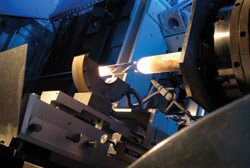Dr. Chris Emslie, Fibercore Ltd., and Dr. Aileen Sansone, Chesapeake Sciences Corp.
Intrinsic sensors based on fiber optics rely on the interaction among the environment, the fiber and the light to generate information about a specific measurand. They benefit from the fiber’s guiding ability, which enables a long optical path to be confined within a small volume. This long optical path can magnify very small optical effects, thereby increasing the sensitivity of the device (see figure).

Intrinsic sensors based on optical fiber benefit from the ability to confine a very long optical path within a small volume. If Michelson and Gale had had access to optical fiber in 1925, their experiment could have fitted into a teacup, and not 200,000 m2 of open ground.
Perhaps the first sensor of this type to be realized is the fiber optic gyroscope, which is used in commercial sensing applications in aircraft, autonomous drones, missile guidance systems and helipad stabilization systems.
Gyroscope fibers and conventional fibers used in telecommunications applications differ in four main aspects: First, gyroscope fiber tends to be polarization-preserving to avoid signal fade that would result if counterpropagating beams recombined with different states of polarization. Second, its diameter is smaller, typically 80 μm, although there is strong interest in diameters as small as 50 μm. These so-called low-profile fibers offer both longer lifetimes because bending stress is proportionally reduced for any specific diameter, and improved accuracy for a given form factor because more fiber can be coiled within any given volume.
Third, numerical apertures tend to be higher (0.16 to 0.20, compared with around 0.13) to provide stronger optical guidance and reduced insertion loss in small-diameter coils. And, finally, primary coating materials with low glass transition temperatures are chosen to avoid degradation of polarization extinction ratio and consequent loss of gyroscope performance, at temperatures down to –55 °C.
Such gyroscopes also have no moving parts and, as a result, are reliable and maintenance-free. Extremely rugged, they have survived and continued to function accurately even when deployed in munitions.
Soundings
Another fiber sensor that currently is receiving increased attention is the fiber hydrophone. There are two primary types of underwater sound systems. The first are passive direct-listening systems that detect sounds made by vessels and marine life passing near the underwater microphones, called hydrophones. The second type, an active detection system, uses a sound source for echo ranging.
Over the past few years, the US Navy has pursued several fiber optic sensor and array development programs, with the goal of enabling electrically passive underwater acoustic sensing. The sensors themselves are typically compliant mandrels that are wrapped with specialty optical fiber. The mandrels respond to the acoustic signals and introduce a phase shift in the light traveling through the fiber. These data are then transmitted by fiber back to the signal processing location.
Sonar systems used throughout the world typically rely upon piezoceramic hydrophones and DC-powered signal conditioning and data telemetry. The hydrophones are configured in arrays that are variations on three basic formats: bottom-mounted lines or grids of hydrophones, hydrophones arranged in a pattern upon a submerged surface, and long flexible hoselike hydrophone arrays, called streamers, intended to be towed through the water. All of these systems, especially streamers, tend to be expensive and are fairly delicate.
Because of the harsh conditions that are routinely encountered at sea, towed arrays are vulnerable to a variety of failure mechanisms, making more robust and less expensive technologies very attractive. Fiber optic hydrophone arrays have the potential to fill both of these needs, with reduced-diameter fibers accommodating tight-bend diameters, and innovative coating packages helping to counter the effects of long periods in saltwater.
Small-form-factor fiber sensors also are important because the physical size of the hydrophones can affect fluid drag and turbulence/noise in towed applications.
Such fibers also differ in basically four ways from telecommunications-type fiber. Diameters are often about 50 μm to minimize bending stress levels (maximize lifetime) and any tendency to bind the deformable mandrel; numerical aperture tends to be very high (0.23 to 0.30) to minimize insertion loss when fibers are wound on streamers’ very small diameter mandrels.
In addition, the standard proof-test level tends to be 3 percent strain (300 kpsi) compared with the telecoms standard of 1 percent strain (100 kpsi) to guarantee lifetimes when wound to very small diameters. And, finally, single-layer coatings are sometimes used to reduce hysteresis (caused by coating deformation) and to simplify the writing of fiber Bragg gratings.
Fiber optic sensing of the intrinsic type has been an active area of research and development for nearly 30 years. After years spent starved of both attention and investment, the fields of fiber sensors and sensing using the latest specialty fiber are once more beginning to flourish.
Meet the authors
Chris Emslie is managing director of Fibercore Ltd. in Southampton, UK; e-mail: [email protected].
Aileen Sansone is a senior fiber optic systems engineer at Chesapeake Sciences Corp. in Millersville, Md.; e-mail: [email protected].